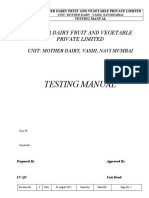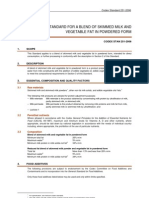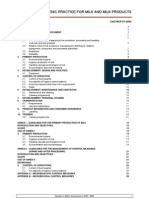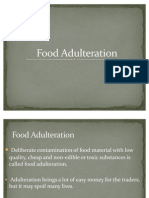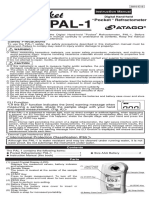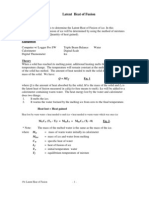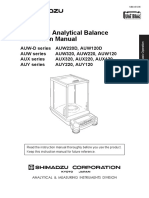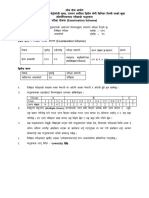NDDB Standard Operating Procedure: Milk Collection Centre (DCS/MPI) With Testing Facilities 11 January 2016
NDDB Standard Operating Procedure: Milk Collection Centre (DCS/MPI) With Testing Facilities 11 January 2016
Uploaded by
Kim KimCopyright:
Available Formats
NDDB Standard Operating Procedure: Milk Collection Centre (DCS/MPI) With Testing Facilities 11 January 2016
NDDB Standard Operating Procedure: Milk Collection Centre (DCS/MPI) With Testing Facilities 11 January 2016
Uploaded by
Kim KimOriginal Title
Copyright
Available Formats
Share this document
Did you find this document useful?
Is this content inappropriate?
Copyright:
Available Formats
NDDB Standard Operating Procedure: Milk Collection Centre (DCS/MPI) With Testing Facilities 11 January 2016
NDDB Standard Operating Procedure: Milk Collection Centre (DCS/MPI) With Testing Facilities 11 January 2016
Uploaded by
Kim KimCopyright:
Available Formats
NDDB
STANDARD OPERATING PROCEDURE
Milk Collection Centre (DCS/MPI) with testing facilities
11 January 2016
Objective
To facilitate the milk collection personnel at the DCS/MPI to follow the
correct procedure for collection and testing of safe and superior quality
milk in the shortest possible time.
Activities
1. Milk Collection.
2. Milk Sampling and Testing.
3. Transportation of milk to Collection Centers (DCS/MPI).
WHAT / STEPS HOW/ STANDARDS
1. Preparatory 1.1. The In-charge/ DCS personnel should report at least one
activities hour before the notified time of milk collection.
1.2. Clean and sanitize all milk collection accessories prior to
milk collection.
1.3. Ensure use of clean & dry sample bottles for milk samples.
1.4. Keep sample bottles upside down without capping in
the cleaned sample tray and allow bottles to dry. Bottle
caps also be allowed to dry in clean and dry place.
1.5. Do not keep, milk samplers, plunger or any other
articles on the floor. Put these on the shelves.
1.6. Ensure that nylon sieve and nylon/ muslin cloth used for
milk filtration is clean and not damaged.
1.7. Organize the milk reception place properly and ensure
that printer stationery and other necessary articles such
as chemicals, reagents, cleaning agents and sanitizers are
in place.
1.8. Ensure that all the chemicals/reagents being used are
under their expiry period.
1.9. Maintain good personnel hygiene as under:
1.9.1. Report to work in good health, dressed in clean
clothes and observe good hygiene.
NDDB
STANDARD OPERATING PROCEDURE
Milk Collection Centre (DCS/MPI) with testing facilities
11 January 2016
WHAT / STEPS HOW/ STANDARDS
1.9.2. Prior to beginning milk collection, wash hands up
to the wrists, with water and soap.
1.9.3. Keep fingernails short by trimming them
regularly.
1.9.4. Avoid handling milk if there are open wounds or
sores, especially on hands and arms.
1.9.5. Avoid handling milk if suffering from cold and
cough.
1.9.6. Men should have trimmed hair (cover head with
suitable cloth/turban) and women keep their hair
ties during the milk collection activity.
1.10. Maintain high standards of general cleaning and
hygiene around the collection centre in the following
manner:
1.10.1. Post ‘No smoking’, ‘No tobacco chewing’ and ‘No
spitting’ signs or posters inside the MPP at
conspicuous places and these should be strictly
adhered to.
1.10.2. Keep stray animals away from the milk
reception area.
1.10.3. Keep the surrounding area clean by ensuring
that there is no accumulation of waste and water
around the DCS/MPI.
1.10.4. Ensure that the milk collection area is not used
for washing hands and so ‘No hand washing’
signs or posters should be posted at the
appropriate place inside the DCS/MPI.
1.10.5. Keep the DCS/MPI clean and maintain good
house keeping.
1.10.6. Do not let the unwanted material to get
accumulated at the work palce.
1.10.7. Ensure that the Centre has adequate protection
from birds, rodents, pests, lizards, insects etc.
1.10.8. Ensure that no loose electric wires are hanging
in the milk collection area. All wires must be
NDDB
STANDARD OPERATING PROCEDURE
Milk Collection Centre (DCS/MPI) with testing facilities
11 January 2016
WHAT / STEPS HOW/ STANDARDS
neatly clipped together.
1.10.9. In all areas particularly during the evening shift
collection the In-Charge should ensure that
insects attracted to the light do not fall into the
milk.
1.10.10. All important information like milk collection
timing. Procurement rate, supervisors contact
number, AH/AI/RBP contact numbers must be
displayed at the notice boards on wall.
Milk testing 1. Keep the milk tester (EMT)/ milk analyzer (UTMA)
equipment: connected to the battery.
2. Ensures that the Data processor/computer, printer, UPS
Electronic and the electronic weigh scale function properly.
Milk-o-Tester
(EMT) and 3. Prior to milk collection, switch on the milk tester/ milk
analyser and allow to warm up for at least 30 minutes.
Ultrasound
Technology- 4. Verify (calibrate) the test results of the milk tester/ milk
based Milk analyser with the control sample.
Analyser
(UTMA) 5. Inform the supervisor if the test instruments do not
indicate results as per the control sample. Follow the
supervisor’s advice to proceed further.
6. Make a note in the log book for any action performed to
correct the calibration of the EMT/milk analyser.
7. Perform pre-operational procedures for the milk tester/
milk analyser such as de-aeration of syringes and zero
check as detailed in the supplier’s operation/ user manual.
1. Ensure that proper power supply and earthing is
Milk weighing available to the electronic weigh scale.
equipment
2. Ensure that the balancing knobs of the weigh scale are
firmly placed on the leveled surface/ floor.
3. Switch on the electronic weigh scale and allow it to
warm up for at least 30 minutes, before starting milk
collection.
NDDB
STANDARD OPERATING PROCEDURE
Milk Collection Centre (DCS/MPI) with testing facilities
11 January 2016
WHAT / STEPS HOW/ STANDARDS
4. Ensure that the electronic weigh scale is calibrated and
certified annually by the Legal Metrology Department.
5. Ensure that the electronic weigh scale is set to auto
tare.
1 Ask pourer members to follow in a queue.
Milk
Collection, 2 Smell the milk brought by producers. Reject the milk with
sampling and off-odors.
testing
3 Check the milk for any extraneous material such as dirt,
hair, dead flies, straw etc. and warn the producer, if found
with extraneous material in milk.
4 Advise milk producers to filter milk using a clean filter
before bringing to DCS/MPI.
5 Check the milk for presence of adulterants organoleptically
and if suspected, keep it aside for test. Reject the milk if
adulterated.
6 Avoid contact with milk during milk collection.
7 Gently stir the milk in the producer’s vessel before drawing
the sample in a sampling bottle.
8 Draw the milk sample from the member’s container and
pour in the sample bottle carefully so as not to spill milk.
9 Write the member code number on the sample bottle.
10 Keep the sample in the numbered sample tray.
11 Steps – if DPMCU (REIL) is available
11.1 Operate the system in Auto mode only.
11.2 Tare the electronic weigh scale and ask member to
pour milk the container kept on the weigh scale.
11.3 Record the milk quantity with the member code in
the system.
11.4 Test the milk sample for %Fat using EMT.
NDDB
STANDARD OPERATING PROCEDURE
Milk Collection Centre (DCS/MPI) with testing facilities
11 January 2016
WHAT / STEPS HOW/ STANDARDS
11.5 Pour the milk sample in the Lactometer Jar carefully
and take the LR reading with the help of caliberated
lactometer.
11.6 Record/capture on DP %Fat test results from EMT,
LR reading and milk quantity by EWS.
11.7 Generate and hand over the milk bill slip to the
member.
12 Step – If DPMCU with Milk Analyzer is available
12.1 Operate the system in Auto mode only.
12.2 Select the Member code.
12.3 Tare the electronic weigh scale and ask member to
pour milk in the container kept on the weigh scale.
12.4 Enter the member code and record/ capture test data
of milk sample for Fat & in the system against the
member code.
12.5 Run the programme to generate the producer milk
receipt.
12.6 Take out and hand over the slip to the member.
13 Keep a track of calving in the village and inform members
not to bring milk of recently calved animals to the center
before seven days from the day of calving.
14 Ensure that containers used by members to bring milk are
clean preferable of SS and with cover.
15 Advice producers not to bring milk in plastic containers/
jerry cans/ empty containers of paints.
16 Keep a tract of average milk quantity poured by individual
member both morning/ evening to check mixing of evening
milk with morning deliveries or vice versa.
17 Fix and follow regularly milk collection timings both
morning/ evening.
NDDB
STANDARD OPERATING PROCEDURE
Milk Collection Centre (DCS/MPI) with testing facilities
11 January 2016
WHAT / STEPS HOW/ STANDARDS
1. Prepare/ Generate milk collection summary sheet with
Post milk total quantity of milk collected.
collection
activities 2. Draw the composite milk sample separately for Cow/
Buffalo milk, after proper plunging from the can and test it
for Fat/ SNF. Record the results in the purchase register
as well as in the dispatch challan.
3. Close and seal the milk Cans.
4. Clean all the milk collection accessories and keep in clean
and dry place.
5. Clean the sample bottles so as the bottles are free from
traces of milk solid.
6. Transport the milk cans to the BMC point following the
stipulated time scheduled or through the head load
arrangement/ or by designated route vehicle.
7. Ensure that milk from milk cans does not spill during the
transportation.
8. In case of milk transport by procurement vehicle, ensure
that the milk cans are sealed and kept ready for dispatch
before vehicle arrival. Keep the filled milk cans under
covered place/ shed.
9. On arrival of vehicle – open the can lids and place the milk
cans on the weigh scale at BMC point.
10. After the milk is poured into the BMC/ CC, collect back
the cleaned milk cans.
11. Remove the lids and keep the milk cans up side down at
the collection centre in a dry place. Lids are kept on the
cans so as no dust accumulate in the can/ lid.
You might also like
- Food Safety Rules - A3 PosterDocument1 pageFood Safety Rules - A3 PosterBhavana BhattNo ratings yet
- Module 3 TranscriptDocument17 pagesModule 3 TranscriptHakim AliNo ratings yet
- Digital Analitic Balance-2400 SeriesDocument36 pagesDigital Analitic Balance-2400 SeriesBernie_Garcia__9886No ratings yet
- MMR ServiceManual K Line e 22007240Document96 pagesMMR ServiceManual K Line e 22007240Eliana CristinaNo ratings yet
- The Art of Tank GaugingDocument26 pagesThe Art of Tank GaugingMOHAMED SHARKAWINo ratings yet
- FoSTaC Milk and Milk Product Advance ManufacturingDocument100 pagesFoSTaC Milk and Milk Product Advance ManufacturingHarsh PatelNo ratings yet
- Cleaning and disinfection of food factories: a practical guideFrom EverandCleaning and disinfection of food factories: a practical guideNo ratings yet
- HACCP Training Material VER 002 05.05.15Document20 pagesHACCP Training Material VER 002 05.05.15Departed MoonNo ratings yet
- Milk HaccpDocument3 pagesMilk HaccpAndre van JaarsveldtNo ratings yet
- Product Spec Pineapple PureeDocument2 pagesProduct Spec Pineapple PureeDelvi AddeliaNo ratings yet
- PS-3733-2019 Part 4 PoultryDocument23 pagesPS-3733-2019 Part 4 Poultrymiz baig100% (2)
- AMAF 32 Final Draft ASEAN Standard For JackfruitDocument8 pagesAMAF 32 Final Draft ASEAN Standard For JackfruitAnonymous a19X9GHZNo ratings yet
- Food Safety Management System 1721277130Document33 pagesFood Safety Management System 1721277130Niaz KhanNo ratings yet
- Food Allergen Management TrainingDocument31 pagesFood Allergen Management Trainingranjan sahaNo ratings yet
- UrlDocument42 pagesUrlmaraki998100% (1)
- Extruder Spheronizer PDFDocument2 pagesExtruder Spheronizer PDFKevinNo ratings yet
- Goodrich SOPDocument51 pagesGoodrich SOPShikha DhakreNo ratings yet
- Agmark Spec - Ghee PDFDocument6 pagesAgmark Spec - Ghee PDFRethinakumar QMSNo ratings yet
- Food Safety and Hygiene LayoutDocument9 pagesFood Safety and Hygiene LayoutJann Kerky100% (1)
- Guidance Document Sixth Edition Version 6.1 PDFDocument130 pagesGuidance Document Sixth Edition Version 6.1 PDFJobanny AlvaradoNo ratings yet
- Pakistan Standard Specification For Wafer BiscuitsDocument7 pagesPakistan Standard Specification For Wafer BiscuitssamanNo ratings yet
- Bean Flour Flow ChartDocument4 pagesBean Flour Flow ChartScribdTranslationsNo ratings yet
- PM-IS-13334-Pt.1 SMP PDFDocument12 pagesPM-IS-13334-Pt.1 SMP PDFSupriya Gothwal100% (1)
- Infant Formula Gmp-EngDocument39 pagesInfant Formula Gmp-EngPhilippe TrotinNo ratings yet
- HACCP Study JoghurtDocument13 pagesHACCP Study JoghurtAliNo ratings yet
- Hazard Analysis Critical Control Point (HACCP) Standard: Prerequisite Programs ChecklistDocument9 pagesHazard Analysis Critical Control Point (HACCP) Standard: Prerequisite Programs ChecklistMar3201No ratings yet
- Allergen Seminar - 3M Allergen TestDocument44 pagesAllergen Seminar - 3M Allergen TesttridewantiwNo ratings yet
- Bakels MSDSDocument4 pagesBakels MSDSMd. Hafijur Rahman PlabonNo ratings yet
- 07 Cleaning of Empty Capsule Loader 07Document2 pages07 Cleaning of Empty Capsule Loader 07Ravi YadavNo ratings yet
- Salt Large Internal Monitoring QAQCDocument28 pagesSalt Large Internal Monitoring QAQCHenok DireNo ratings yet
- Khoa Based SweetsDocument17 pagesKhoa Based SweetsRonak RawatNo ratings yet
- Corporate QualityDocument13 pagesCorporate QualityAshok LenkaNo ratings yet
- BAM Chapter 10 Detection of Listeria Monocytogenes in Foods and Environmental Samples, and Enumeration of Listeria Monocytogenes in Foods FDADocument26 pagesBAM Chapter 10 Detection of Listeria Monocytogenes in Foods and Environmental Samples, and Enumeration of Listeria Monocytogenes in Foods FDAIwan RidwantoNo ratings yet
- Vitamin Analysis by HPLC: Technical NoteDocument4 pagesVitamin Analysis by HPLC: Technical NoteJuan PerezNo ratings yet
- Good Warehouse PracticesDocument4 pagesGood Warehouse PracticesGURPREET SINGHNo ratings yet
- Product SpecificationsDocument1 pageProduct SpecificationsMichael LandryNo ratings yet
- Philippine National Philippine National Philippine National Philippine National Standard Standard Standard StandardDocument19 pagesPhilippine National Philippine National Philippine National Philippine National Standard Standard Standard StandardAngelica DuevoNo ratings yet
- Manual Mother DairyDocument89 pagesManual Mother DairyFahimNo ratings yet
- Post Market SurveillenceDocument2 pagesPost Market SurveillenceMahmoud DomourNo ratings yet
- Process Flow Chart For Cattle Feeds.Document2 pagesProcess Flow Chart For Cattle Feeds.bevek timsinaNo ratings yet
- Milk N Milk ProductsDocument13 pagesMilk N Milk Productsruchipickle100% (1)
- Blend Skim Milk PowderDocument4 pagesBlend Skim Milk PowderAnanto1977No ratings yet
- SOP For Checking of Precision BalanceDocument1 pageSOP For Checking of Precision BalanceBejoy KarimNo ratings yet
- Indian Dairy IndustryDocument39 pagesIndian Dairy IndustryAmrish GargNo ratings yet
- BRC6 - Introduction To Acceptance Procedure Raw MaterialsDocument8 pagesBRC6 - Introduction To Acceptance Procedure Raw MaterialsSherylNo ratings yet
- CXP 057eDocument33 pagesCXP 057eArunee KongpengNo ratings yet
- Lecture 4 B GHP MilkDocument22 pagesLecture 4 B GHP MilkGuleRia ShiVani100% (2)
- SOP For Automatic Capsule Filling LineDocument8 pagesSOP For Automatic Capsule Filling LineSolomonNo ratings yet
- Sannan Haider Khan 2020-AG-477 Sara Hassan 2020-AG-GROUP# 19Document22 pagesSannan Haider Khan 2020-AG-477 Sara Hassan 2020-AG-GROUP# 19Sannan Haider KhanNo ratings yet
- EXP 3 DesignDocument52 pagesEXP 3 DesignnasuhaNo ratings yet
- Food AdulterationDocument13 pagesFood AdulterationNavita MapariNo ratings yet
- Comparing HACCP and HARPCDocument3 pagesComparing HACCP and HARPCIndri MardiyanaNo ratings yet
- Medioint Lifescience PVT - LTD.: Standard Operating ProcedureDocument4 pagesMedioint Lifescience PVT - LTD.: Standard Operating ProcedureChoudhary DhirajNo ratings yet
- Agmark App FormDocument34 pagesAgmark App FormramcatNo ratings yet
- Model FoodSec Plan ProcessingDocument23 pagesModel FoodSec Plan ProcessingJorge Gregorio SeguraNo ratings yet
- Manual of Methods OF Analysis of Foods: Cereal and Cereal ProductsDocument70 pagesManual of Methods OF Analysis of Foods: Cereal and Cereal ProductsRajam SankarNo ratings yet
- Atago PAL-1 Refractometer Instruction ManualDocument5 pagesAtago PAL-1 Refractometer Instruction ManualJosé CamposNo ratings yet
- 4 SOP Spectrophotometric Iron ContentDocument4 pages4 SOP Spectrophotometric Iron ContentnananthNo ratings yet
- Traceability Complete FinalDocument14 pagesTraceability Complete Finalmdsanchezo8373No ratings yet
- SOP For Milk Tester at Milk Collection Point and Chilling CenterDocument2 pagesSOP For Milk Tester at Milk Collection Point and Chilling CenterKim Kim0% (1)
- Cleaning The Milking Utensils and Milking MachinesDocument7 pagesCleaning The Milking Utensils and Milking MachinesKim KimNo ratings yet
- 0 Responsibilities of Supplier and Buyer 1Document1 page0 Responsibilities of Supplier and Buyer 1Kim KimNo ratings yet
- Introduction To Bulk Milk Collection Handbook 2010Document12 pagesIntroduction To Bulk Milk Collection Handbook 2010Kim KimNo ratings yet
- Technology Guide: The Kla Difference: Technology, Experience, Knowledge, and ServiceDocument31 pagesTechnology Guide: The Kla Difference: Technology, Experience, Knowledge, and ServiceKim KimNo ratings yet
- The Case For Higher Level Power ManagementDocument6 pagesThe Case For Higher Level Power ManagementKim KimNo ratings yet
- JJ FMEA SampleDocument6 pagesJJ FMEA SampleRahul YadavNo ratings yet
- OLED Kitchen Scale With ArduinoDocument7 pagesOLED Kitchen Scale With ArduinohandsontecNo ratings yet
- P.5 Primary Five Sci Scheme of WorkDocument18 pagesP.5 Primary Five Sci Scheme of WorkTusiime Hillary BushariraNo ratings yet
- Shimadzu Singles PDFDocument32 pagesShimadzu Singles PDFP RAJAVELUNo ratings yet
- Year 1 and 2 Mass Capacity and TemperatureDocument37 pagesYear 1 and 2 Mass Capacity and TemperaturejmlearnsmNo ratings yet
- A Level Physics Parctical WorkDocument137 pagesA Level Physics Parctical WorkSessanga RonaldNo ratings yet
- Lab Report Hydrostatics Force Theory, Conclusion&Recommendations.Document14 pagesLab Report Hydrostatics Force Theory, Conclusion&Recommendations.Darryl ShiluamaNo ratings yet
- Pendulum ScaleDocument4 pagesPendulum ScaleVarunNo ratings yet
- Operating Manual: HRB Series Intelligent Weighing MachineDocument22 pagesOperating Manual: HRB Series Intelligent Weighing MachineSaavedra Alberto LuisNo ratings yet
- S76A AMM Chapter 08Document12 pagesS76A AMM Chapter 08Paulo BernardoNo ratings yet
- The Plate Load Test in The Application of Dynamic Compaction Test of Subgrade Bearing CapacityDocument6 pagesThe Plate Load Test in The Application of Dynamic Compaction Test of Subgrade Bearing Capacityivy_publisherNo ratings yet
- Magnetic Weighing Scale Investigatory ProjectDocument14 pagesMagnetic Weighing Scale Investigatory ProjectJan Ivan MontenegroNo ratings yet
- Calculator Weight Problems 2Document3 pagesCalculator Weight Problems 2Mohamed HamdyNo ratings yet
- Year 7 Particle Model 0f Solid Liquid Gas Mark - SchemeDocument4 pagesYear 7 Particle Model 0f Solid Liquid Gas Mark - SchemeJo PatrickNo ratings yet
- Nepal Standard Measurement and Weigh ActDocument20 pagesNepal Standard Measurement and Weigh ActGautamNo ratings yet
- Company Profile PDFDocument37 pagesCompany Profile PDFAntoNo ratings yet
- 19c Latent Heat of FusionDocument3 pages19c Latent Heat of FusionAndrae Tennant100% (1)
- STD 10physics Force SolutionsDocument38 pagesSTD 10physics Force SolutionsHemant ChaudhariNo ratings yet
- Matter HomeworkDocument32 pagesMatter HomeworkJames PerriamNo ratings yet
- Manual Balanca Shimadzu Auw220DDocument117 pagesManual Balanca Shimadzu Auw220DmrenaultNo ratings yet
- Catalogo PfiferDocument308 pagesCatalogo PfiferGustavo CassiolatoNo ratings yet
- Metrology KharidarDocument3 pagesMetrology KharidarSanu Kaji MaharjanNo ratings yet
- PHYSICS PRACTICUM REPORT - Muhammad Farhan AziziDocument13 pagesPHYSICS PRACTICUM REPORT - Muhammad Farhan AziziFarhan AziziNo ratings yet
- Calibration of Platform Scale: By: Kent John A. Caburnay & Jose CanilloDocument17 pagesCalibration of Platform Scale: By: Kent John A. Caburnay & Jose CanilloSam OmpadNo ratings yet
- Kern PFB Precision Balance - User ManualDocument48 pagesKern PFB Precision Balance - User ManualLorNo ratings yet
- Magnetic Pull Test Kits: Analog & Traceable Digital VersionsDocument4 pagesMagnetic Pull Test Kits: Analog & Traceable Digital VersionsOficina Técnica Santa RosaNo ratings yet
- Physics Year 10 - September 2022 - ExamDocument18 pagesPhysics Year 10 - September 2022 - ExamsmakheleNo ratings yet





































